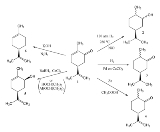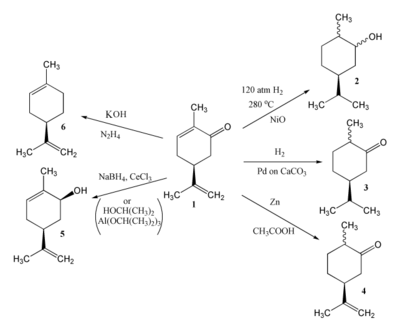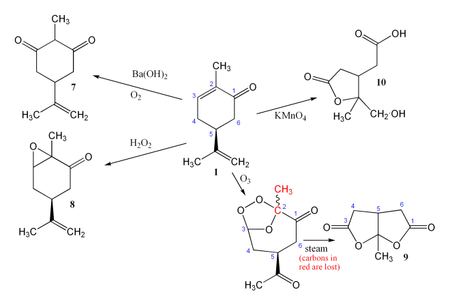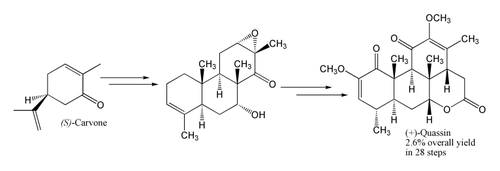
Carvone
Encyclopedia
Carvone is a member of a family of chemicals called terpenoids
. Carvone is found naturally in many essential oil
s, but is most abundant in the oils from seeds of caraway
(Carum carvi) and dill
.
. Its mirror image, S-(+)-carvone, smells like caraway
. The fact that the two enantiomers are perceived as smelling differently is proof that olfactory receptor
s must contain chiral groups, allowing them to respond more strongly to one enantiomer than to the other. Not all enantiomers have distinguishable odors. Squirrel monkey
s have also been found to be able to discriminate between carvone enantiomers.
The two forms are also referred to by older names, with dextro-, d- referring to S-carvone, and laevo-, l- referring to R-carvone.
seed oil (from Anethum graveolens), and also in mandarin orange
peel oil. R-(–)-Carvone is present at levels greater than 51% in spearmint oil (Mentha spicata
), which is produced on a scale of around 1500 tonnes annually. This isomer also occurs in kuromoji oil. Some oils, like gingergrass oil, contain a mixture of both enantiomers. Many other natural oils, for example peppermint
oil, contain lower concentrations of carvones.
, and the structure was finally elucidated by Wagner in 1894.
oil; the laevo-form from the oils containing it, by first forming its addition compound with hydrogen sulfide
, decomposing this by potassium hydroxide
in ethanol
, and distilling the product in a current of steam. It may be synthetically prepared from limonene nitrosochloride, alcoholic converting this compound into 1-carvoxime, which on boiling with dilute sulfuric acid
yields l-carvone. The major use of d-limonene is as a precursor to carvone. The large scale availability of orange rinds, a byproduct in the production of orange juice, has made limonene cheaply available, and synthetic carvone correspondingly inexpensively prepared.
The biosynthesis
of carvone is by oxidation of limonene
.
and acetic acid
reduce carvone to give dihydrocarvone (4). MPV reduction using propan-2-ol and aluminium isopropoxide
effects reduction of the carbonyl
group only to provide carveol
(5); a combination of sodium borohydride
and CeCl3
(Luche reduction
) is also effective. Hydrazine
and potassium hydroxide
give limonene
(6) via a Wolff-Kishner reduction
.

of carvone can also lead to a variety of products. In the presence of an alkali such as Ba(OH)2
, carvone is oxidised by air or oxygen
to give the diketone 7. With hydrogen peroxide
the epoxide
8 is formed. Carvone may be cleaved using ozone
followed by steam, giving dilactone
9, while KMnO4
gives 10.

, carvone undergoes conjugate additions
of nucleophiles. For example, carvone reacts with lithium dimethylcuprate
to place a methyl group trans to the isopropenyl group with good stereoselectivity
. The resulting enolate can then be allylated using allyl bromide
to give ketone 11.

and alternative medicine
.
.
of natural products
. For example, (S)-(+)-carvone was used to begin a 1998 synthesis of the terpenoid quassin
:

and uroterpenolone. (4R,6S)-(–)-carveol
is also formed as a minor product via reduction by NADPH. (4S)-(+)-carvone is likewise converted to (4S,6S)-(+)-carveol. This mainly occurs in the liver and involves cytochrome P450 oxidase
and (+)-trans-carveol dehydrogenase
.
Terpene
Terpenes are a large and diverse class of organic compounds, produced by a variety of plants, particularly conifers, though also by some insects such as termites or swallowtail butterflies, which emit terpenes from their osmeterium. They are often strong smelling and thus may have had a protective...
. Carvone is found naturally in many essential oil
Essential oil
An essential oil is a concentrated hydrophobic liquid containing volatile aroma compounds from plants. Essential oils are also known as volatile oils, ethereal oils or aetherolea, or simply as the "oil of" the plant from which they were extracted, such as oil of clove...
s, but is most abundant in the oils from seeds of caraway
Caraway
Caraway also known as meridian fennel, or Persian cumin is a biennial plant in the family Apiaceae, native to western Asia, Europe and Northern Africa....
(Carum carvi) and dill
Dill
Dill is a perennial herb. It is the sole species of the genus Anethum, though classified by some botanists in a related genus as Peucedanum graveolens C.B.Clarke.-Growth:...
.
Stereoisomerism and odor
Carvone forms two mirror image forms or enantiomers: R-(–)-carvone smells like spearmintSpearmint
Mentha spicata syn. M. cordifolia is a species of mint native to much of Europe and southwest Asia, though its exact natural range is uncertain due to extensive early cultivation. It grows in wet soils...
. Its mirror image, S-(+)-carvone, smells like caraway
Caraway
Caraway also known as meridian fennel, or Persian cumin is a biennial plant in the family Apiaceae, native to western Asia, Europe and Northern Africa....
. The fact that the two enantiomers are perceived as smelling differently is proof that olfactory receptor
Olfactory receptor
Olfactory receptors expressed in the cell membranes of olfactory receptor neurons are responsible for the detection of odor molecules. Activated olfactory receptors are the initial player in a signal transduction cascade which ultimately produces a nerve impulse which is transmitted to the brain...
s must contain chiral groups, allowing them to respond more strongly to one enantiomer than to the other. Not all enantiomers have distinguishable odors. Squirrel monkey
Squirrel monkey
The squirrel monkeys are the New World monkeys of the genus Saimiri. They are the only genus in the subfamily Saimirinae.Squirrel monkeys live in the tropical forests of Central and South America in the canopy layer. Most species have parapatric or allopatric ranges in the Amazon, while S...
s have also been found to be able to discriminate between carvone enantiomers.
The two forms are also referred to by older names, with dextro-, d- referring to S-carvone, and laevo-, l- referring to R-carvone.
Occurrence
S-(+)-Carvone is the principal constituent (50-70%) of the oil from caraway seeds (Carum carvi), which is produced on a scale of about 10 tonnes per year. It also occurs to the extent of about 40-60% in dillDill
Dill is a perennial herb. It is the sole species of the genus Anethum, though classified by some botanists in a related genus as Peucedanum graveolens C.B.Clarke.-Growth:...
seed oil (from Anethum graveolens), and also in mandarin orange
Mandarin orange
The orange, also known as the ' or mandarine , is a small citrus tree with fruit resembling other oranges. Mandarin oranges are usually eaten plain or in fruit salads...
peel oil. R-(–)-Carvone is present at levels greater than 51% in spearmint oil (Mentha spicata
Spearmint
Mentha spicata syn. M. cordifolia is a species of mint native to much of Europe and southwest Asia, though its exact natural range is uncertain due to extensive early cultivation. It grows in wet soils...
), which is produced on a scale of around 1500 tonnes annually. This isomer also occurs in kuromoji oil. Some oils, like gingergrass oil, contain a mixture of both enantiomers. Many other natural oils, for example peppermint
Peppermint
Peppermint is a hybrid mint, a cross between the watermint and spearmint . The plant, indigenous to Europe, is now widespread in cultivation throughout all regions of the world...
oil, contain lower concentrations of carvones.
History
Caraway was used for medicinal purposes by the ancient Romans, but carvone was probably not isolated as a pure compound until Varrentrapp obtained it in 1841. It was originally called carvol by Schweizer. Goldschmidt and Zűrrer identified it as a ketone related to limoneneLimonene
Limonene is a colourless liquid hydrocarbon classified as a cyclic terpene. The more common D isomer possesses a strong smell of oranges. It is used in chemical synthesis as a precursor to carvone and as a renewably-based solvent in cleaning products....
, and the structure was finally elucidated by Wagner in 1894.
Preparation
The dextro-form is obtained practically pure by the fractional distillation of carawayCaraway
Caraway also known as meridian fennel, or Persian cumin is a biennial plant in the family Apiaceae, native to western Asia, Europe and Northern Africa....
oil; the laevo-form from the oils containing it, by first forming its addition compound with hydrogen sulfide
Hydrogen sulfide
Hydrogen sulfide is the chemical compound with the formula . It is a colorless, very poisonous, flammable gas with the characteristic foul odor of expired eggs perceptible at concentrations as low as 0.00047 parts per million...
, decomposing this by potassium hydroxide
Potassium hydroxide
Potassium hydroxide is an inorganic compound with the formula KOH, commonly called caustic potash.Along with sodium hydroxide , this colorless solid is a prototypical strong base. It has many industrial and niche applications. Most applications exploit its reactivity toward acids and its corrosive...
in ethanol
Ethanol
Ethanol, also called ethyl alcohol, pure alcohol, grain alcohol, or drinking alcohol, is a volatile, flammable, colorless liquid. It is a psychoactive drug and one of the oldest recreational drugs. Best known as the type of alcohol found in alcoholic beverages, it is also used in thermometers, as a...
, and distilling the product in a current of steam. It may be synthetically prepared from limonene nitrosochloride, alcoholic converting this compound into 1-carvoxime, which on boiling with dilute sulfuric acid
Sulfuric acid
Sulfuric acid is a strong mineral acid with the molecular formula . Its historical name is oil of vitriol. Pure sulfuric acid is a highly corrosive, colorless, viscous liquid. The salts of sulfuric acid are called sulfates...
yields l-carvone. The major use of d-limonene is as a precursor to carvone. The large scale availability of orange rinds, a byproduct in the production of orange juice, has made limonene cheaply available, and synthetic carvone correspondingly inexpensively prepared.
The biosynthesis
Biosynthesis
Biosynthesis is an enzyme-catalyzed process in cells of living organisms by which substrates are converted to more complex products. The biosynthesis process often consists of several enzymatic steps in which the product of one step is used as substrate in the following step...
of carvone is by oxidation of limonene
Limonene
Limonene is a colourless liquid hydrocarbon classified as a cyclic terpene. The more common D isomer possesses a strong smell of oranges. It is used in chemical synthesis as a precursor to carvone and as a renewably-based solvent in cleaning products....
.
Reduction
There are three double bonds in carvone capable of reduction; the product of reduction depends on the reagents and conditions used. Catalytic hydrogenation of carvone (1) can give either carvomenthol (2) or carvomenthone (3). ZincZinc
Zinc , or spelter , is a metallic chemical element; it has the symbol Zn and atomic number 30. It is the first element in group 12 of the periodic table. Zinc is, in some respects, chemically similar to magnesium, because its ion is of similar size and its only common oxidation state is +2...
and acetic acid
Acetic acid
Acetic acid is an organic compound with the chemical formula CH3CO2H . It is a colourless liquid that when undiluted is also called glacial acetic acid. Acetic acid is the main component of vinegar , and has a distinctive sour taste and pungent smell...
reduce carvone to give dihydrocarvone (4). MPV reduction using propan-2-ol and aluminium isopropoxide
Aluminium isopropoxide
Aluminium isopropoxide is the chemical compound usually described with the formula Al3, where i-Pr is the isopropyl group . This colourless solid is a useful reagent in organic synthesis...
effects reduction of the carbonyl
Carbonyl
In organic chemistry, a carbonyl group is a functional group composed of a carbon atom double-bonded to an oxygen atom: C=O. It is common to several classes of organic compounds, as part of many larger functional groups....
group only to provide carveol
Carveol
Carveol is a natural unsaturated, monocyclic monoterpenoid alcohol that is a constituent of spearmint essential oil in the form of cis--carveol. It is a colorless fluid soluble in water and oils, but insoluble in water and has an odor and flavor that resemble those of spearmint and caraway...
(5); a combination of sodium borohydride
Sodium borohydride
Sodium borohydride, also known as sodium tetrahydridoborate, is an inorganic compound with the formula NaBH4. This white solid, usually encountered as a powder, is a versatile reducing agent that finds wide application in chemistry, both in the laboratory and on a technical scale. Large amounts are...
and CeCl3
Cerium(III) chloride
Cerium chloride , also known as cerous chloride or cerium trichloride, is a compound of cerium and chlorine. It is a white hygroscopic solid; It rapidly absorbs water on exposure to moist air to form a hydrate which appears to be of variable composition, though the heptahydrate CeCl3·7 H2O is known...
(Luche reduction
Luche reduction
Luche reduction is the selective organic reduction of ketones to alcohols with lanthanoid chlorides such as cerium chloride and sodium borohydride. The Luche reduction can be conducted chemoselectively toward ketone in the presence of aldehyde or toward α,β-unsaturated ketone in the presence of...
) is also effective. Hydrazine
Hydrazine
Hydrazine is an inorganic compound with the formula N2H4. It is a colourless flammable liquid with an ammonia-like odor. Hydrazine is highly toxic and dangerously unstable unless handled in solution. Approximately 260,000 tons are manufactured annually...
and potassium hydroxide
Potassium hydroxide
Potassium hydroxide is an inorganic compound with the formula KOH, commonly called caustic potash.Along with sodium hydroxide , this colorless solid is a prototypical strong base. It has many industrial and niche applications. Most applications exploit its reactivity toward acids and its corrosive...
give limonene
Limonene
Limonene is a colourless liquid hydrocarbon classified as a cyclic terpene. The more common D isomer possesses a strong smell of oranges. It is used in chemical synthesis as a precursor to carvone and as a renewably-based solvent in cleaning products....
(6) via a Wolff-Kishner reduction
Wolff-Kishner reduction
The Wolff–Kishner reduction is a chemical reaction that fully reduces a ketone to an alkane.The method originally involved heating the hydrazine with sodium ethoxide in a sealed vessel at about 180 °C. Other bases have been found equally effective...
.

Oxidation
OxidationRedox
Redox reactions describe all chemical reactions in which atoms have their oxidation state changed....
of carvone can also lead to a variety of products. In the presence of an alkali such as Ba(OH)2
Barium hydroxide
Barium hydroxide is the chemical compound with the formula Ba2. Also known as baryta, it is one of the principal compounds of barium. The white granular monohydrate is the usual commercial form.-Preparation:...
, carvone is oxidised by air or oxygen
Oxygen
Oxygen is the element with atomic number 8 and represented by the symbol O. Its name derives from the Greek roots ὀξύς and -γενής , because at the time of naming, it was mistakenly thought that all acids required oxygen in their composition...
to give the diketone 7. With hydrogen peroxide
Hydrogen peroxide
Hydrogen peroxide is the simplest peroxide and an oxidizer. Hydrogen peroxide is a clear liquid, slightly more viscous than water. In dilute solution, it appears colorless. With its oxidizing properties, hydrogen peroxide is often used as a bleach or cleaning agent...
the epoxide
Epoxide
An epoxide is a cyclic ether with three ring atoms. This ring approximately defines an equilateral triangle, which makes it highly strained. The strained ring makes epoxides more reactive than other ethers. Simple epoxides are named from the parent compound ethylene oxide or oxirane, such as in...
8 is formed. Carvone may be cleaved using ozone
Ozone
Ozone , or trioxygen, is a triatomic molecule, consisting of three oxygen atoms. It is an allotrope of oxygen that is much less stable than the diatomic allotrope...
followed by steam, giving dilactone
Lactone
In chemistry, a lactone is a cyclic ester which can be seen as the condensation product of an alcohol group -OH and a carboxylic acid group -COOH in the same molecule...
9, while KMnO4
Potassium permanganate
Potassium permanganate is an inorganic chemical compound with the formula KMnO4. It is a salt consisting of K+ and MnO4− ions. Formerly known as permanganate of potash or Condy's crystals, it is a strong oxidizing agent. It dissolves in water to give intensely purple solutions, the...
gives 10.

Conjugate additions
As an α,beta;-unsaturated ketoneEnone
An enone is an unsaturated chemical compound or functional group consisting of a conjugated system of an alkene and a ketone. The simplest enone is methyl vinyl ketone or CH2=CHCOCH3....
, carvone undergoes conjugate additions
Nucleophilic conjugate addition
Nucleophilic conjugate addition is a type of organic reaction. Ordinary nucleophilic additions or 1,2-nucleophilic additions deal mostly with additions to carbonyl compounds. Simple alkene compounds do not show 1,2 reactivity due to lack of polarity, unless the alkene is activated with special...
of nucleophiles. For example, carvone reacts with lithium dimethylcuprate
Gilman reagent
A Gilman reagent is a lithium and copper reagent compound, R2CuLi, where R is an organic radical. These are useful because they react with organic chlorides, bromides, and iodides to replace the halide group with an R group. This is extremely useful in creating larger molecules from smaller...
to place a methyl group trans to the isopropenyl group with good stereoselectivity
Stereoselectivity
In chemistry, stereoselectivity is the property of a chemical reaction in which a single reactant forms an unequal mixture of stereoisomers during the non-stereospecific creation of a new stereocenter or during the non-stereospecific transformation of a pre-existing one...
. The resulting enolate can then be allylated using allyl bromide
Allyl bromide
Allyl bromide is an organic halide. Its refractive index is 1.4697 . Allyl bromide is an alkylating agent used in synthesis of polymers, pharmaceuticals, allyls and other organic compounds. Physically, allyl bromide is a clear liquid with an intense, acrid, and persistent smell...
to give ketone 11.

Uses
Both carvones are used in the food and flavor industry. R-(-)-Carvone is also used for air freshening products and, like many essential oils, oils containing carvones are used in aromatherapyAromatherapy
Aromatherapy is a form of alternative medicine that uses volatile plant materials, known as essential oils, and other aromatic compounds for the purpose of altering a person's mind, mood, cognitive function or health....
and alternative medicine
Alternative medicine
Alternative medicine is any healing practice, "that does not fall within the realm of conventional medicine." It is based on historical or cultural traditions, rather than on scientific evidence....
.
Food applications
As the compound most responsible for the flavor of caraway, dill and spearmint, carvone has been used for millennia in food. Wrigley's Spearmint Gum is soaked in R-(–)-carvone and powdered with sugarSugar
Sugar is a class of edible crystalline carbohydrates, mainly sucrose, lactose, and fructose, characterized by a sweet flavor.Sucrose in its refined form primarily comes from sugar cane and sugar beet...
.
Agriculture
S-(+)-Carvone is also used to prevent premature sprouting of potatoes during storage, being marketed in the Netherlands for this purpose under the name Talent.Insect Control
R-(–)-carvone has been proposed for use as a mosquito repellent, and the U.S. Environmental Protection Agency is reviewing a request to register it as a pesticide.Organic synthesis
Carvone is available inexpensively in both enantiomerically pure forms, making it an attractive starting material for the asymmetric total synthesisTotal synthesis
In organic chemistry, a total synthesis is, in principle, the complete chemical synthesis of complex organic molecules from simpler pieces, usually without the aid of biological processes. In practice, these simpler pieces are commercially available in bulk and semi-bulk quantities, and are often...
of natural products
Secondary metabolite
Secondary metabolites are organic compounds that are not directly involved in the normal growth, development, or reproduction of an organism. Unlike primary metabolites, absence of secondary metabolities does not result in immediate death, but rather in long-term impairment of the organism's...
. For example, (S)-(+)-carvone was used to begin a 1998 synthesis of the terpenoid quassin
Quassin
Quassin is a white bitter, crystalline substance extracted from the quassia tree. It is one of the most bitter substances found in nature with a bitter threshold of 0.08 ppm and it is 50 times more bitter than quinine....
:

Metabolism
In the body, in vivo studies indicate that both enantiomers of carvone are mainly metabolized into dihydrocarvonic acid, carvonic acidCarvonic acid
Carvonic acid, or α-methylene-4-methyl-5-oxo-3-cyclohexene-1-acetic acid, is a terpenoid formed by metabolism of carvone in humans....
and uroterpenolone. (4R,6S)-(–)-carveol
Carveol
Carveol is a natural unsaturated, monocyclic monoterpenoid alcohol that is a constituent of spearmint essential oil in the form of cis--carveol. It is a colorless fluid soluble in water and oils, but insoluble in water and has an odor and flavor that resemble those of spearmint and caraway...
is also formed as a minor product via reduction by NADPH. (4S)-(+)-carvone is likewise converted to (4S,6S)-(+)-carveol. This mainly occurs in the liver and involves cytochrome P450 oxidase
Cytochrome P450 oxidase
The cytochrome P450 superfamily is a large and diverse group of enzymes. The function of most CYP enzymes is to catalyze the oxidation of organic substances. The substrates of CYP enzymes include metabolic intermediates such as lipids and steroidal hormones, as well as xenobiotic substances...
and (+)-trans-carveol dehydrogenase
(+)-trans-carveol dehydrogenase
In enzymology, a -trans-carveol dehydrogenase is an enzyme that catalyzes the chemical reaction-trans-carveol + NAD+ \rightleftharpoons --carvone + NADH + H+...
.

